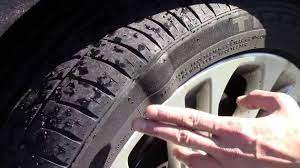There are a number of reasons why tires get those bubbles and cracks. Your tire could be wearing out due to normal use, or it could be because you’re not rotating your tires often enough. There may be damage to the sidewall as a result of hitting a curb when parallel parking, driving over potholes at high speeds, or running over other obstacles on the road. You could have nails or screws in your tire from construction work on your street, and if you don’t notice them right away, they can cause internal damage that leads to those bubbles appearing. Driving with underinflated tires can also lead to sidewall bulges by causing the tire’s steel belts to flex and bend inconsistently.
Bubbles on your tires could be due to underinflation
It’s usually the case that the bubbles you see on your tires are caused by underinflation. Underinflated tires experience more wear and tear, as well as greater heat buildup, than properly inflated ones do. This can cause the air inside the tire to expand, which in turn can cause a bulge or bubble in the side of your tire.
Low inflation is one of the main reasons why you get bubbles on your tires
Underinflation is one of the most common causes of tire failure. However, it’s also a very preventable one. The four primary reasons to keep an eye on your tire pressure are safety, cost, performance and the environment.
From a safety perspective, underinflation increases the likelihood that your tires will fail while you’re driving—and no one wants to experience that. It doesn’t matter if you’re just running errands around town or traveling from state to state; driving with bad tires can lead to a dangerous situation for both you and other drivers on the road. Additionally, keeping your tires inflated properly can actually help improve handling performance in various driving conditions.
In terms of cost efficiency, underinflated tires wear more quickly than those kept at their recommended inflation levels. Because they flex more than properly inflated tires as they roll down the highway, they tend to wear faster along their outer edges—a condition known as “feathering.” When this happens, traction is reduced in wet conditions and overall tread life is shortened significantly. That means you’ll be replacing tires more often than if you stay on top of your tire pressure maintenance routine (which should include checking regularly). Not only does that lead to higher expenses for drivers over time—it’s not great for our planet either.
If you see a bubble in your tire than it could be due to underinflation
You might be wondering, what is air pressure? Or, what’s the difference between an underinflated and an overinflated tire? Find out in this guide. But first, let’s look at what causes bubbles in tires.
It could be due to underinflation. If you’re not sure how to tell if your tires are inflated properly and want a quick fix for the problem, you can always take your car to a tire shop and have it done for free. However, with just a few steps you’ll learn how simple it is to inflate tires yourself.
The first thing to know is that air pressure changes with temperature: when temperatures rise or fall outside of normal driving conditions (between 60 degrees Fahrenheit and 90 degrees Fahrenheit), normally-maintained tires will experience fluctuations in their internal pressure levels. A good rule of thumb would be around 20-30 psi (pounds per square inch) when cold — which means they’ve been sitting unused all night long — but they may need additional air after driving some distance on hot pavement during daylight hours because the drive caused them warm up considerably more than before leaving home!

